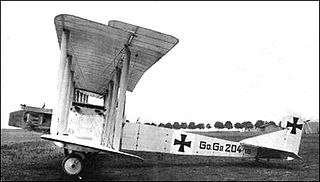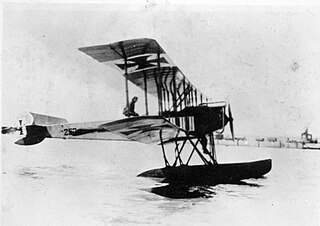
The Gotha G.V was a heavy bomber used by the Luftstreitkräfte during World War I. Designed for long-range service and built by Gothaer Waggonfabrik AG, the Gotha G.V was used principally as a night bomber.

The AEG G.IV was a biplane bomber aircraft designed and produced by the German aircraft manufacturer Allgemeine Elektrizitäts-Gesellschaft. It saw action during the First World War with the Luftstreitkräfte.

The AEG G.V was a biplane bomber aircraft of World War I, a further refinement of the AEG G.IV. The type saw limited production before the Armistice, and never entered operational service. It featured a 600 kg (1,320 lb) bombload.

The Zeppelin-Staaken R.VI was a four-engined German biplane strategic bomber of World War I, and the only Riesenflugzeug design built in any quantity.

The Maybach Mb IVa was a water-cooled aircraft and airship straight-six engine developed in Germany during World War I by Maybach-Motorenbau GmbH, a subsidiary of Zeppelin. It was one of the world's first series-produced engines designed specifically for high-altitude use. It was quite different engine design than the previous Maybach Mb.IV, not just a simple modification.

The Friedrichshafen G.IV and G.V respectively were heavy bombers that were designed and manufactured in Germany during World War I by Flugzeugbau Friedrichshafen. The G.IV saw limited use by the Luftstreitkräfte for tactical and limited strategic bombing operations, while the G.V and a follow-on design, the FF.62 did not fly until after the Armistice.

The Gotha G.II series was a heavy bomber used by the Luftstreitkräfte during World War I.

The Gotha G.III was a twin-engine pusher biplane heavy bomber used by the Luftstreitkräfte during World War I. It succeeded the G.II in production and differed primarily in powerplant and in armament details. The G.II's unreliable V-8 Mercedes D.IV was replaced by the new inline six-cylinder 190 kW (250 hp) Mercedes D.IVa engine. The G.III also had a strengthened fuselage with an extra 7.92 mm (0.312 in) machine gun firing through a ventral gun tunnel in the belly to protect the underside of the tail.

The Gotha G.IV was a heavy bomber used by the Luftstreitkräfte during World War I. It was the first mass-produced relatively large airplane.

The Gotha G.VII was a bomber aircraft produced in Germany during the final months of World War I. With the strategic bombing campaign effectively over, it was intended to be a high-speed tactical bomber with a secondary reconnaissance capability.

The Gotha WD.2 and its derivatives were a family of military reconnaissance aircraft produced in Germany just before and during the early part of World War I.

The Gotha WD.7 was a reconnaissance floatplane developed in the German Empire during World War I.
The Gotha G.VI was an experimental bomber aircraft designed and built in Germany during World War I.

The Zeppelin-Staaken Riesenflugzeuge were a series of very large bomber aircraft - Riesenflugzeuge, usually powered by four or more engines, designed and built in Germany from 1915 to 1919.

The Zeppelin-Lindau Rs.III was a large four-engined monoplane flying boat designed by Claudius Dornier and built during 1917 on the German side of Lake Constance at the Zeppelin-Lindau works.

The LFG Roland G.I was a large prototype single-engine biplane bomber built in Germany in 1915, during World War I. It had a single engine buried in the fuselage driving pusher configuration propellers mounted on outriggers.

The LVG G.III was a large, twin engine triplane bomber built in Germany near the end of World War I. Only one was completed.

The Rumpler C.X, produced under the company designation Rumpler 8C 14, was a German two-seat observation aircraft. It was developed from the earlier Rumpler 8C 13 prototype by Rumpler in early 1918. The prototype had a similar wing design to the Rumpler C.VII, powered by a 260 hp (194 kW) Mercedes D.IVa engine and was later powered by a 240 hp (179 kW) Maybach Mb.IVa. The C.X had the highest top speed and service ceiling of all German C-type aircraft and an order was placed for the aircraft in August 1918, but few were built and tested before the war ended.
The Halberstadt C.VIII was a prototype two-seat general-purpose biplane built by Halberstadt during World War I.
The Kawanishi K-3 was a Japanese, fast, multi-purpose civil transport aircraft from the early 1920s. Despite its good performance it was eclipsed by the release of Army surplus machines and only one was built.
















